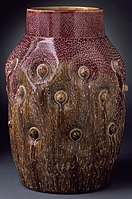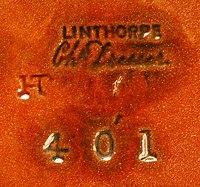
Troika was an art pottery that operated in Cornwall from 1962 to 1983. It was founded by three people, Leslie Illsley, Jan Thompson and Benny Sirota who took over the Powell and Wells Pottery at Wheal Dream, where Sirota had previously worked as a decorator and driver. The name is from the Russian тройка, meaning "a set of three", or triumvirate.

MIMA, or Middlesbrough Institute of Modern Art, is a contemporary art gallery based in the centre of Middlesbrough, England. The gallery was formally launched on Sunday 27 January 2007; since 2014 it has been part of Teesside University.

Christopher Dresser was a British designer and design theorist, now widely known as one of the first and most important independent designers. He was a pivotal figure in the Aesthetic Movement and a major contributor to the allied Anglo-Japanese or Modern Style, both of which originated in England and had long-lasting international influence.
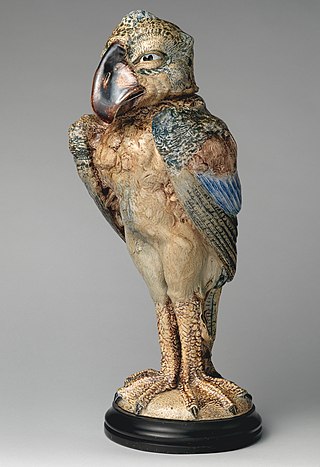
The four Martin Brothers were pottery manufacturers in London from 1873 to 1914. In their own day their Martinware was described as art pottery, and they were one of the earliest potteries making this, but in modern terms they fit better into the studio pottery category, which was invented later.

Barbotine is the French for ceramic slip, or a mixture of clay and water used for moulding or decorating pottery. In English the term is used for three different techniques of decorating pottery, though in all cases mainly for historical works. For clarity, these types are numbered here as A-C.

Mintons was a major company in Staffordshire pottery, "Europe's leading ceramic factory during the Victorian era", an independent business from 1793 to 1968. It was a leader in ceramic design, working in a number of different ceramic bodies, decorative techniques, and "a glorious pot-pourri of styles - Rococo shapes with Oriental motifs, Classical shapes with Medieval designs and Art Nouveau borders were among the many wonderful concoctions". As well as pottery vessels and sculptures, the firm was a leading manufacturer of tiles and other architectural ceramics, producing work for both the Houses of Parliament and United States Capitol.

Blue Pottery is widely recognized as a traditional craft of Jaipur of Central Asian origin. The name 'blue pottery' comes from the eye-catching cobalt blue dye used to color the pottery. It is one of many Eurasian types of blue and white pottery, and related in the shapes and decoration to Islamic pottery and, more distantly, Chinese pottery.

Dorman Museum is a local and social history museum on the town centre side of Albert Park, Linthorpe in Middlesbrough, North Yorkshire, England. It is one of two museums operated by the local borough council, along with the Captain Cook birthplace in Stewart Park.

Linthorpe is a suburb of Middlesbrough in the Borough of Middlesbrough, North Yorkshire, England. It contains two wards: Linthorpe with a population of 9,711 and Park with a population of 5,919.
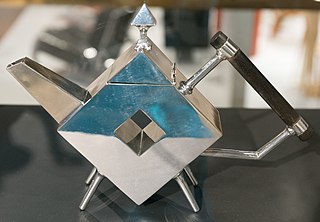
The Anglo-Japanese style developed in the United Kingdom through the Victorian period and early Edwardian period from approximately 1851 to the 1910s, when a new appreciation for Japanese design and culture influenced how designers and craftspeople made British art, especially the decorative arts and architecture of England, covering a vast array of art objects including ceramics, furniture and interior design. Important centres for design included London and Glasgow.

Victorian majolica properly refers to two types of majolica made in the second half of the 19th century in Europe and America.

The Modern Style is a style of architecture, art, and design that first emerged in the United Kingdom in the mid-1880s. It was the first Art Nouveau style worldwide, and it represents the evolution of the Arts and Crafts movement which was native to Great Britain. The Modern Style provided the base and intellectual background for the Art Nouveau movement and was adapted by other countries, giving birth to local variants such as Jugendstil and the Vienna Secession. It was cultivated and disseminated through the Liberty department store and The Studio magazine.
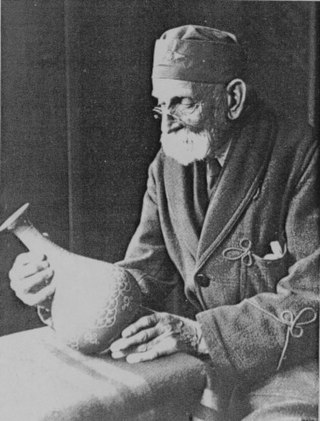
Ashby Potters' Guild was an English art pottery existing from 1909 to 1922.
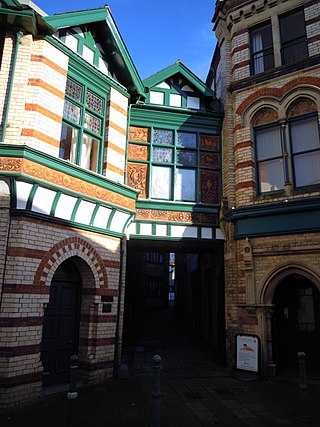
Brannam Pottery was a British pottery started by Thomas Backway Brannam in Barnstaple, Devon, England, in 1848. It later became part of the "rustic" wing of the art pottery movement.

Art pottery is a term for pottery with artistic aspirations, made in relatively small quantities, mostly between about 1870 and 1930. Typically, sets of the usual tableware items are excluded from the term; instead the objects produced are mostly decorative vessels such as vases, jugs, bowls and the like which are sold singly. The term originated in the later 19th century, and is usually used only for pottery produced from that period onwards. It tends to be used for ceramics produced in factory conditions, but in relatively small quantities, using skilled workers, with at the least close supervision by a designer or some sort of artistic director. Studio pottery is a step up, supposed to be produced in even smaller quantities, with the hands-on participation of an artist-potter, who often performs all or most of the production stages. But the use of both terms can be elastic. Ceramic art is often a much wider term, covering all pottery that comes within the scope of art history, but "ceramic artist" is often used for hands-on artist potters in studio pottery.
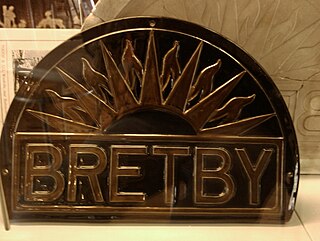
Bretby Art Pottery was an art pottery studio founded in 1882 by Henry Tooth and William Ault in Woodville, Derbyshire, where production began on 25 October 1883. Tooth went into partnership with Ault following his successful leadership of the celebrated Linthorpe Pottery in Middlesbrough where he had been recommended as general manager by the designer Dr Christopher Dresser in 1879.

Gertrud Amon Natzler was an Austrian-American ceramicist, who together with her husband Otto Natzler created some of the most praised ceramics art of the 20th century, helping to elevate ceramics to the status of a fine art.

Art Nouveau glass is fine glass in the Art Nouveau style. Typically the forms are undulating, sinuous and colorful art, usually inspired by natural forms. Pieces are generally larger than drinking glasses, and decorative rather than practical, other than for use as vases and lighting fittings; there is little tableware. Prominently makers, from the 1890s onwards, are in France René Lalique, Emile Gallé and the Daum brothers, the American Louis Comfort Tiffany, Christopher Dresser in Scotland and England, and Friedrich Zitzman, Karl Koepping and Max Ritter von Spaun in Germany. Art Nouveau glass included decorative objects, vases, lamps, and stained glass windows. It was usually made by hand, and was usually colored with metal oxides while in a molten state in a furnace.
Emily Hesse was a multidisciplinary British visual artist, author and activist.

William Ault was an English potter, involved with a number of companies in the Staffordshire potteries and South Derbyshire making art pottery and more utilitarian wares.




